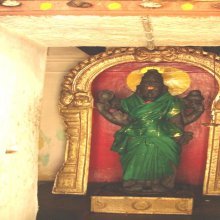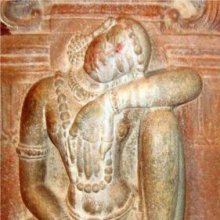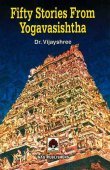Rudraksha, Rudrākṣa, Rudra-aksha: 17 definitions
Introduction:
Rudraksha means something in Hinduism, Sanskrit, Marathi, Hindi, biology. If you want to know the exact meaning, history, etymology or English translation of this term then check out the descriptions on this page. Add your comment or reference to a book if you want to contribute to this summary article.
The Sanskrit term Rudrākṣa can be transliterated into English as Rudraksa or Rudraksha, using the IAST transliteration scheme (?).
Images (photo gallery)
In Hinduism
Ayurveda (science of life)
Source: Google Books: Essentials of AyurvedaRudrākṣa (रुद्राक्ष).—The Sanskrit name for an important Ayurvedic drug.—Rudrākṣa beads are commonly worn by the devotees of Śiva. It is cold, soothing and useful in hypertension, insanity, burning snesation and fever.

Āyurveda (आयुर्वेद, ayurveda) is a branch of Indian science dealing with medicine, herbalism, taxology, anatomy, surgery, alchemy and related topics. Traditional practice of Āyurveda in ancient India dates back to at least the first millenium BC. Literature is commonly written in Sanskrit using various poetic metres.
Shaivism (Shaiva philosophy)
Source: Wisdom Library: ŚaivismRudrākṣa (रुद्राक्ष, “rosary of seeds”) refers to one of the five kinds of external marks of an ācārya (“Śaiva preceptor”), according to Nigamajñāna (Śaiva teacher of the 16th century) in his Śaivāgamaparibhāṣāmañjarī.

Shaiva (शैव, śaiva) or Shaivism (śaivism) represents a tradition of Hinduism worshiping Shiva as the supreme being. Closely related to Shaktism, Shaiva literature includes a range of scriptures, including Tantras, while the root of this tradition may be traced back to the ancient Vedas.
Purana and Itihasa (epic history)
Source: archive.org: Puranic EncyclopediaRudrākṣa (रुद्राक्ष).—(Elaco Carpus seeds) Beads for rosaries. General information. A holy thing worn by devotees. In the Purāṇas much importance is attached to Rudrākṣa. In Devī Bhāgavata, Skandha 11, there is a story stating how Rudrākṣa came to be honoured in this way. (See full article at Story of Rudrākṣa from the Puranic encyclopaedia by Vettam Mani)
Source: archive.org: Shiva Purana - English TranslationRudrākṣa (रुद्राक्ष) refer to sacred beads to be worn on the body, according to the Śivapurāṇa 1.23, while explaining the importance of the glorification of Rudrākṣa:—“Śiva’s name, the ashes and the Rudrākṣa beads—the three are very holy and are on a par with Triveṇī (the confluence of the three holy rivers). [...] The man who has no ashes on his forehead, has not worn Rudrākṣa on his body and does not utter names of Śiva shall be shunned as one does a base man. As said by Brahmā, Śiva’s name is on a par with Gaṅgā, the ash is equal to Yamunā and Rudrākṣa destroys all sins (and is equal to Sarasvatī)”.
According to the Śivapurāṇa 1.25, while explaining the greatness of Rudrākṣa:—“[...] Rudrākṣas grown in Gauḍa land became great favourites of Śiva. They were grown in Mathurā, Laṅkā, Ayodhyā, Malaya, Sahya mountain, Kāśī and other places. They are competent to break asunder the clustered sins unbearable to the others, as the sacred texts have declared. At my bidding they were classified into Brahmins, Kṣatriyas, Vaiśyas and Śūdras. These Rudrākṣas are of auspicious nature. The colours of the four types of Rudrākṣas are respectively white (śveta), red (rakta), yellow (pīta) and black (kṛṣṇa). All people shall wear the Rudrākṣa of their own varna”.

The Purana (पुराण, purāṇas) refers to Sanskrit literature preserving ancient India’s vast cultural history, including historical legends, religious ceremonies, various arts and sciences. The eighteen mahapuranas total over 400,000 shlokas (metrical couplets) and date to at least several centuries BCE.
Shaktism (Shakta philosophy)
Source: Google Books: ManthanabhairavatantramRudrākṣa (रुद्राक्ष) refers to one of the thirty-six sacred trees, according to the Ṣaṭsāhasrasaṃhitā, an expansion of the Kubjikāmatatantra: the earliest popular and most authoritative Tantra of the Kubjikā cult.—Accordingly, “According to the Kula teaching (these) [i.e., Rudrākṣa] are the most excellent Kula trees that give accomplishments and liberation. (They are full of) Yoginīs, Siddhas, Lords of the Heroes and hosts of gods and demons. One should not touch them with one’s feet or urinate and defecate on them or have sex etc. below them. One should not cut etc. or burn them. Having worshipped and praised them regularly with their own flowers and shoots, one should always worship the Śrīkrama with devotion with their best fruits and roots. [...]”.

Shakta (शाक्त, śākta) or Shaktism (śāktism) represents a tradition of Hinduism where the Goddess (Devi) is revered and worshipped. Shakta literature includes a range of scriptures, including various Agamas and Tantras, although its roots may be traced back to the Vedas.
Biology (plants and animals)
Source: Wisdom Library: Local Names of Plants and DrugsRudraksha [रुद्राक्ष] in the Nepali language is the name of a plant identified with Elaeocarpus serratus L. from the Elaeocarpaceae (Rudraksh) family having the following synonyms: Elaeocarpus malabaricus, Elaeocarpus cuneatus. For the possible medicinal usage of rudraksha, you can check this page for potential sources and references, although be aware that any some or none of the side-effects may not be mentioned here, wether they be harmful or beneficial to health.
Rudraksha [రుద్రాక్శ] in the Telugu language is the name of a plant identified with Guazuma ulmifolia from the Sterculiaceae (Cacao) family having the following synonyms: Theobroma guazuma, Guazuma tomentosa.
Rudraksha [ರುದ್ರಾಕ್ಷ] in the Kannada language, ibid. previous identification.
Rudraksha [रुद्राक्ष] in the Sanskrit language, ibid. previous identification.
Source: Google Books: CRC World Dictionary (Regional names)1) Rudraksha in India is the name of a plant defined with Elaeocarpus angustifolius in various botanical sources. This page contains potential references in Ayurveda, modern medicine, and other folk traditions or local practices It has the synonym Ganitrus sphaericus Gaertn.) (Ganitrus Gaertner, from the Malayan/Indonesian name. (among others).
2) Rudraksha is also identified with Elaeocarpus sphaericus It has the synonym Ganitrus sphaerica Gaertn. (etc.).
3) Rudraksha is also identified with Elaeocarpus tuberculatus It has the synonym Monocera tuberculata (Roxb.) Wight & Arn..
Example references for further research on medicinal uses or toxicity (see latin names for full list):
· Das Pflanzenreich (1895)
· Hortus Bengal. (1814)
· Fragmenta Phytographiae Australiae (1860)
· Hortus Bengalensis, or ‘a Catalogue of the Plants Growing in the Hounourable East India Company's Botanical Garden at Calcutta’ (1814)
· Flora Indica (1832)
· A General History of the Dichlamydeous Plants (1831)
If you are looking for specific details regarding Rudraksha, for example extract dosage, pregnancy safety, health benefits, side effects, chemical composition, diet and recipes, have a look at these references.

This sections includes definitions from the five kingdoms of living things: Animals, Plants, Fungi, Protists and Monera. It will include both the official binomial nomenclature (scientific names usually in Latin) as well as regional spellings and variants.
Languages of India and abroad
Marathi-English dictionary
Source: DDSA: The Molesworth Marathi and English Dictionaryrudrākṣa (रुद्राक्ष).—m (S) A tree sacred to Shiva, Eleocarpus lanceolatus or ganitrus. 2 The berry of it. Used in making necklaces, rosaries &c. Ex. jō karī sahasrarudrākṣadhāraṇa || tyāsa vanditi aditinandana ||.
Source: DDSA: The Aryabhusan school dictionary, Marathi-Englishrudrākṣa (रुद्राक्ष).—m A tree sacred to śiva; the berry of it.
Marathi is an Indo-European language having over 70 million native speakers people in (predominantly) Maharashtra India. Marathi, like many other Indo-Aryan languages, evolved from early forms of Prakrit, which itself is a subset of Sanskrit, one of the most ancient languages of the world.
Sanskrit dictionary
Source: DDSA: The practical Sanskrit-English dictionaryRudrākṣa (रुद्राक्ष).—a kind of tree. (-kṣam) 1 a rosary.
2) the berry of this tree, used for rosaries; भस्मोद्धूलन भद्रमस्तु भवते रुद्राक्षमाले शुभम् (bhasmoddhūlana bhadramastu bhavate rudrākṣamāle śubham) K. P.1.
Derivable forms: rudrākṣaḥ (रुद्राक्षः).
Rudrākṣa is a Sanskrit compound consisting of the terms rudra and akṣa (अक्ष).
Source: Cologne Digital Sanskrit Dictionaries: Shabda-Sagara Sanskrit-English DictionaryRudrākṣa (रुद्राक्ष).—m.
(-kṣaḥ) A tree, (Eleocarpus ganitrus, Rox.) n.
(-kṣaṃ) The berry of the Eleocarpus, of which rosaries are usually made. E. rudra Siva, and akṣa from akṣi the eye.
Source: Cologne Digital Sanskrit Dictionaries: Monier-Williams Sanskrit-English Dictionary1) Rudrākṣa (रुद्राक्ष):—[from rudra > rud] m. ‘R°-eyed’, Elaeocarpus Ganitrus or its berry (used for rosaries), [Horace H. Wilson] (cf. [Religious Thought and Life in India 67, 82])
2) [v.s. ...] a rosary (gender doubtful), [Rājataraṅgiṇī]
3) [v.s. ...] Name of an Upaniṣad (gender d°)
Source: Cologne Digital Sanskrit Dictionaries: Yates Sanskrit-English DictionaryRudrākṣa (रुद्राक्ष):—[rudrā+kṣa] (kṣaḥ) 1. m. A tree (Elæocarpus ganitrus). n. The berry.
[Sanskrit to German]
Sanskrit, also spelled संस्कृतम् (saṃskṛtam), is an ancient language of India commonly seen as the grandmother of the Indo-European language family (even English!). Closely allied with Prakrit and Pali, Sanskrit is more exhaustive in both grammar and terms and has the most extensive collection of literature in the world, greatly surpassing its sister-languages Greek and Latin.
Hindi dictionary
Source: DDSA: A practical Hindi-English dictionaryRudrakṣa (रुद्रक्ष):—(nm) the seeds of the tree Eleocarpus ganitrus used for making rosaries.
...
Kannada-English dictionary
Source: Alar: Kannada-English corpusRudrākṣa (ರುದ್ರಾಕ್ಷ):—[noun] = ರುದ್ರಾಕ್ಷಿ [rudrakshi].
Kannada is a Dravidian language (as opposed to the Indo-European language family) mainly spoken in the southwestern region of India.
See also (Relevant definitions)
Partial matches: Aksha, Rudra.
Starts with: Rudraksha-kamba, Rudrakshabharana, Rudrakshadharana, Rudrakshadharanamantra, Rudrakshahalasu, Rudrakshakalpa, Rudrakshala, Rudraksham, Rudrakshamahatmya, Rudrakshamahatmyavarnana, Rudrakshamala, Rudrakshamalika, Rudrakshapariksha, Rudrakshavalaya, Rudrakshopanishad.
Ends with: Bada rudraksha, Ekamukhirudraksha, Khoto-rudraksha, Nepal rudraksha.
Full-text (+196): Rudrakshamalika, Ekedashamukha, Dvivaktra, Sama, Kantakasamyuta, Trivaktra, Dvadashasya, Navavaktra, Caturdashamukha, Saptavaktra, Dashavaktra, Vrana, Krimidushta, Trayodashamukha, Nameru, Kantakahina, Janardana, Avritta, Kantaka, Kalagni.
Relevant text
Search found 41 books and stories containing Rudraksha, Rudrākṣa, Rudra-aksha, Rudraksa, Rudra-akṣa, Rudra-aksa, Rudrakṣa; (plurals include: Rudrakshas, Rudrākṣas, akshas, Rudraksas, akṣas, aksas, Rudrakṣas). You can also click to the full overview containing English textual excerpts. Below are direct links for the most relevant articles:
The Devi Bhagavata Purana (by Swami Vijñanananda)
Chapter 4 - On the greatness of the Rudrākṣam < [Book 11]
Chapter 7 - On the greatness of one faced, etc., Rudrākṣam < [Book 11]
Chapter 5 - On the Rudrākṣam rosaries < [Book 11]
The Shiva Purana (by J. L. Shastri)
Chapter 25 - The greatness of Rudrākṣa < [Section 1 - Vidyeśvara-saṃhitā]
Chapter 26 - Śiva’s incarnation as Vaiśyanātha < [Section 3 - Śatarudra-saṃhitā]
Chapter 30 - Prayer to the lord of gods < [Section 2.5 - Rudra-saṃhitā (5): Yuddha-khaṇḍa]
Puranic encyclopaedia (by Vettam Mani)
The Skanda Purana (by G. V. Tagare)
Chapter 20 - The Great Efficacy of Rudrākṣa: The Story of Mahānandā < [Section 3 - Brāhmottara-khaṇḍa]
Chapter 13 - The Fight between Devas and Asuras < [Section 1 - Kedāra-khaṇḍa]
Chapter 95 - Vyāsa’s Arms Get Paralysed < [Section 2 - Uttarārdha]
Shaiva Upanishads (A Critical Study) (by Arpita Chakraborty)
21. Śiva Mahāpurāṇa on Rudrākṣa < [Chapter 4 - A Critical approach to Rudrākṣa based on Śaiva Upaniṣads]
11-12. Process and Method of Wearing Rudrākṣa < [Chapter 4 - A Critical approach to Rudrākṣa based on Śaiva Upaniṣads]
8. Various faces of Rudrākṣa and their benefits < [Chapter 4 - A Critical approach to Rudrākṣa based on Śaiva Upaniṣads]
The Padma Purana (by N.A. Deshpande)
Chapter 59 - In Praise of Rudrākṣa < [Section 1 - Sṛṣṭi-khaṇḍa (section on creation)]
Chapter 60 - In Praise of Tulasī < [Section 1 - Sṛṣṭi-khaṇḍa (section on creation)]
Related products







